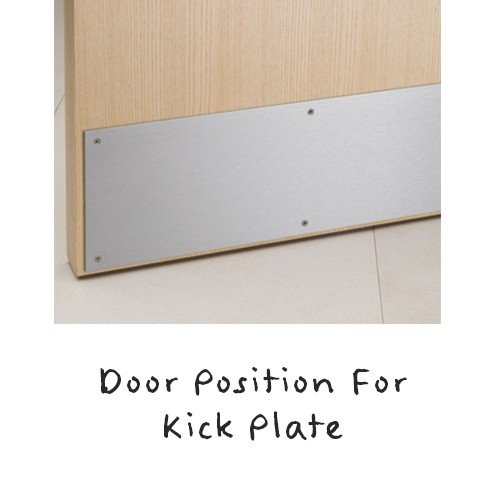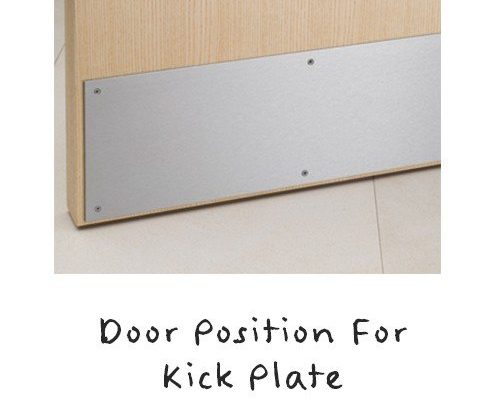
Now, if you’re using a standard Schlage, Kwikset, or Yale brand door, the kick plate may be original, or you might’ve added it later as a little home improvement project. Doesn’t really matter which brand—when it starts vibrating every time the door shuts, the problem can drive you up the wall. Let’s dig into what causes this, and how to get your peace and quiet back.
What Is A Kick Plate, And Why Does It Vibrate?
A kick plate might seem like a minor detail, but it does a big job. Installed on the push side of doors, it guards the wood or paint from scuffs, dirt, and dings. In homes with kids, pets, or frequent visitors, that little sheet of metal prevents a lot of wear and tear.
But here’s the thing: over time, the kick plate can start to vibrate when the door closes. Why? Usually, it’s all about loose screws, thin metal, or a poor fit. When the door moves, a loosely attached plate acts like a tuning fork. Even a slight gap between the kick plate and the door can let air or vibrations build up—and suddenly, you’ve got a rattle or buzz every time the door shuts. If you’ve ever walked through a house and thought, “Why does that sound like a cymbal at my feet?”—it’s almost always the kick plate.
Some doors, like heavy entry doors with strong closing mechanisms or thick weatherstripping, can slam hard enough to amplify the problem. Others, especially those with cheaper or thinner plates, are born rattlers: you close the door even gently, and you hear it. Knowing what you’re dealing with is the first step to a real fix.
Common Causes Of Kick Plate Vibration
Let me explain a few reasons why your kick plate vibrates when the door closes:
- Loose fasteners: The screws or nails holding the plate in place can work loose over time. Every time you shut the door, those loose spots act like a drum or bell—vibrating and echoing the sound.
- Improper plate fit: If the plate wasn’t installed perfectly flat, or if the door itself has warped slightly, a gap can form behind the plate. Even a barely visible gap will let the plate flex and vibrate.
- Thin or low-quality material: The cheapest kick plates are sometimes little more than thin aluminum. They’re easy to dent and especially prone to vibrating with even small impacts.
- Poor installation: If the installer didn’t use enough screws, or spread them too far apart, sections of the plate can flex easily—leading to that tell-tale buzz.
Honestly, most homeowners first notice the problem after a season of heavy use (lots of slamming, humidity changes, or temperature swings). It can start small—a gentle rattle, a click, or a metallic buzz—and then get worse with each closing.
How To Find The Source Of The Vibration
So, you want to fix the rattling. First, you need to confirm it’s the kick plate and not something else (like a loose threshold or door sweep). Here’s what to do:
- Listen carefully: Close the door slowly. If the vibration only occurs right as the door latches, that’s a clue. Knock gently on the kick plate—is that the same sound?
- Check for loose screws: Gently wiggle the corners and edges of the plate. If any part moves or clicks, it’s probably your culprit.
- Look for visible gaps: With the door open, get close and look for any space between the plate and the door. Even a thin shadow means the plate isn’t flush.
- Inspect plate thickness: If the plate is extremely thin, tap it with a knuckle—does it ‘ping’ easily? Thinner plates vibrate more than sturdy ones.
You might be surprised—sometimes, what sounds like a whole door shaking is really just one loose screw on the kick plate. Taking a few minutes to check pays off in faster fixes.
Simple Fixes For A Vibrating Kick Plate
You don’t need fancy tools or pro skills to quiet a vibrating kick plate. Most fixes can be handled in a few steps:
- Tighten loose screws: Grab a screwdriver (usually a Phillips) and tighten every screw on the plate. Start at the corners, then work toward the center. If a screw spins loosely, you may need to replace it with a slightly wider one, or fill the hole with a wood toothpick and wood glue before re-tightening.
- Add more fasteners: If the plate only has two or three screws, add an extra one or two in the middle sections. Make sure the screw heads match the existing ones—otherwise you’ll notice the difference every time you see the door.
- Check screw length: Sometimes, installers use screws that are too short, especially on metal doors. Swapping them for slightly longer screws (that still fit flush) can make a big difference.
- Use double-sided tape or construction adhesive: For a little added stability, put a few squares of heavy-duty double-sided tape behind the plate before tightening the screws. In some cases, a thin bead of construction adhesive along the back can stop vibrations cold. Just don’t overdo it—you’ll want to be able to remove the plate later if needed.
Each of these steps works for both brand-name doors (like Schlage, Kwikset, or Yale) and generic ones. Here’s the thing: most kick plates, no matter where they’re from, use the same basic installation method—so the “fix” is universal.
Advanced Troubleshooting: When Simple Fixes Don’t Work
If you’ve tried the basics and the kick plate still vibrates, it’s time to go a little deeper. Sometimes, the issue runs beneath the surface—literally.
- Door warping: If your door is old or has seen lots of weather changes, it might have warped slightly. This can pull the kick plate away from the wood or create subtle curves. Hold a straight-edge ruler or level against the plate; look for gaps. If the door’s out of shape, you may need to re-mount the kick plate using new holes and fresh hardware.
- Replace the plate: If the plate itself is super thin or feels like a soda can, consider upgrading. A heavier gauge (thicker) kick plate is much less likely to vibrate. Any hardware store can help you find a compatible replacement for your door’s brand and size.
- Sound dampening materials: In rare cases, you can glue a thin strip of rubber or felt to the back of the plate before reinstalling. This works a lot like felt pads under chair legs—absorbing vibration before it gets loud. Use material that can handle moisture and temperature changes if your door faces the elements.
Think of advanced troubleshooting like “leveling up” your fix. Most folks never need it, but if you’re still getting that buzz after basic steps, these upgrades will usually solve the problem for good.
Should You Call A Professional For Kick Plate Troubles?
You might be wondering if you need to hire a handyman or locksmith just for a vibrating kick plate. Here’s my honest take: rarely. Most issues are simple enough for anyone comfortable with a drill or screwdriver to handle.
There are a few cases, though, where a pro makes sense:
- Specialty doors: If you have an antique, custom, or fire-rated door, the kick plate may be attached differently (especially if the plate covers electrical wiring in smart locks or security doors).
- Damaged hardware: If screws are stripped or broken, or if the door’s been cracked or splintered, a professional will have the right tools and know-how for repairs.
- Warranty issues: For new doors covered by a manufacturer’s warranty—especially high-end brands like Yale or Schlage—tampering too much could void coverage.
For the vast majority of standard doors, you’re safe to do this yourself, especially since the fix is usually just a matter of tightening or adding screws. If you’re ever unsure, take a quick photo of the issue and show it to a hardware store pro—they’ve seen it all.
Comparing Kick Plate Materials: Does It Matter?
Here’s something a lot of folks overlook: kick plate material matters more than you might think. Think of it like car doors—thin sheet metal rattles, while heavier steel stays quiet.
- Aluminum: Lightweight, affordable, but prone to vibration—especially if not installed perfectly flush. Scratches easily, so it can get ugly over time.
- Brass or stainless steel: Heavier and sturdier. Far less likely to vibrate, and they look sharper longer. They resist dents and scratches, so if your door takes a beating (from kids, pets, or weather), it’s a solid upgrade.
- Plastic/Vinyl: Cheaper still, and usually reserved for interior doors or light-use areas. These almost never vibrate, but they’re rarely used on exterior doors for durability reasons.
Honestly, if you’re replacing the kick plate and want the quietest solution, spend a little more on stainless steel or solid brass. You’ll notice the difference every time you close the door—and your ears will thank you.
How To Prevent Kick Plate Rattling In The Future
Let me give you a few tips to keep your kick plate from vibrating down the line:
- Check screws seasonally: As part of a quick home maintenance routine, tighten them once or twice a year, especially after big weather swings.
- Clean the plate and door: Dirt and grime can sneak under the plate and lift it up slightly over time. Wipe the plate and the adjoining wood or metal a couple times a year.
- Use sturdy materials: When it’s time to replace the kick plate, pick one that’s at least 0.05 inches thick. It might cost a bit more upfront, but it’s the “set it and forget it” solution for this issue.
- Avoid over-slamming the door: It sounds obvious, but teaching kids (and adults) to close doors gently can prolong not just the kick plate, but the whole door’s hardware.
Keeping an eye on these little details can save you from troubleshooting a vibrating kick plate all over again.
Final Thoughts: Getting Peace And Quiet Back At The Door
At the end of the day, a kick plate that vibrates when the door closes is more than just a weird noise—it’s a reminder that even the smallest parts of our homes need a little attention now and then. Whether you’ve got a top-brand Schlage or a no-name metal door, the fix is usually within easy reach. Start with the basics: tighten, secure, and check for gaps. If the buzz doesn’t quit, try a sturdier plate or add some vibration-dampening material.
No matter which route you take, don’t let a small rattle drive you crazy. The satisfaction of closing your door to a quiet, peaceful “thud”—instead of a metallic shimmy—is worth grabbing the screwdriver for. Now you’re set for a quieter home, and you’ll never look at a kick plate the same way again.
